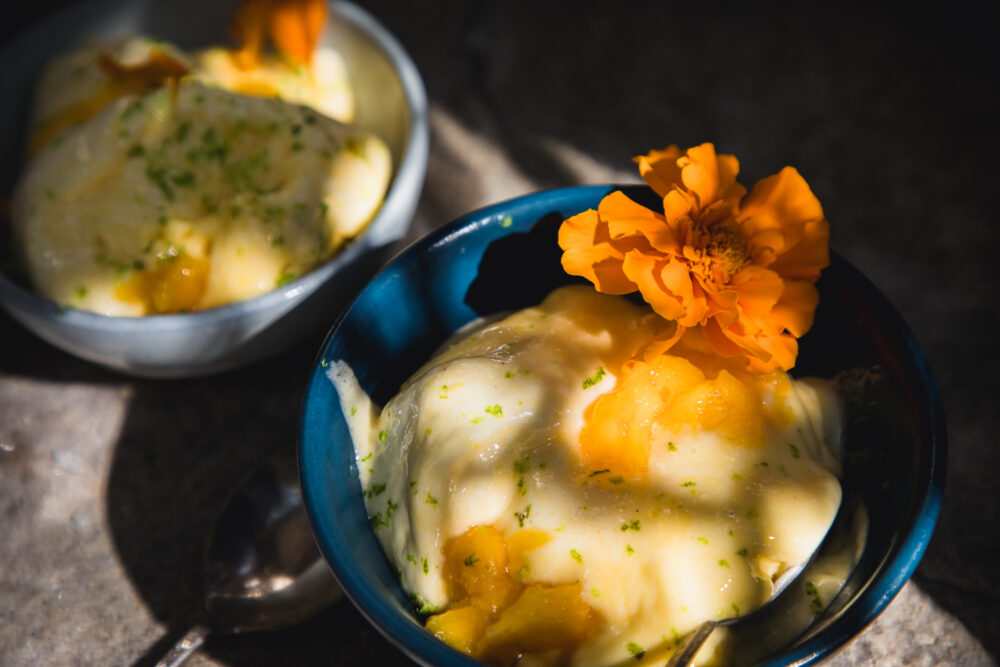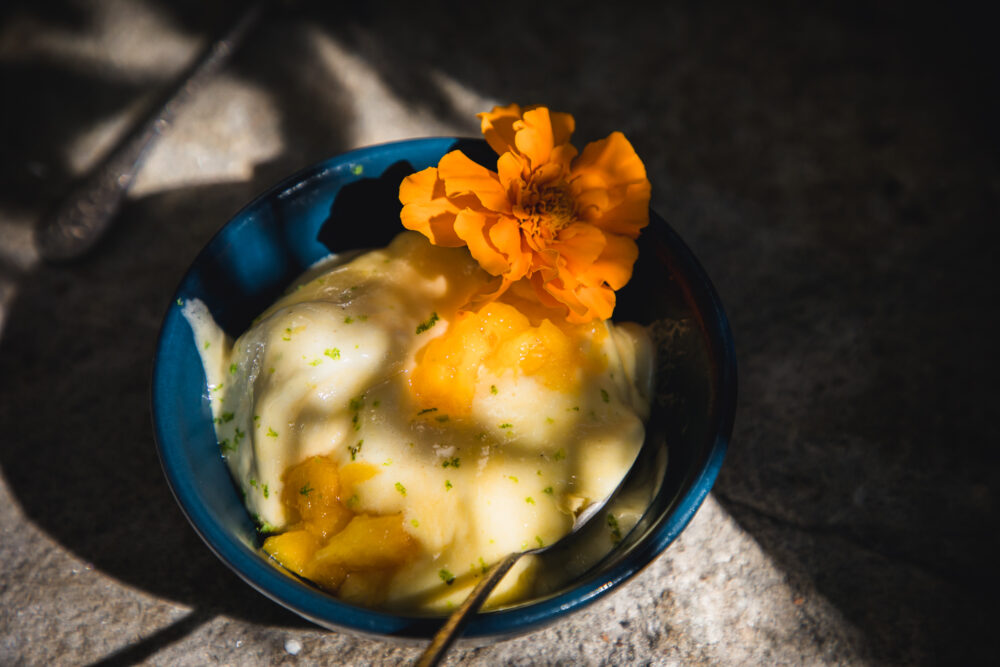
Frozen mango meringue – a light and dreamy dessert
This frozen mango meringue was inspired by one of my favourite desserts in Annabel Langbein’s cookbook, “The Free Range Cook.” Annabel has a beautiful recipe for a strawberry cloud cake, made of frozen strawberry meringue, spooned over a biscuit base.
I love the texture of the uncooked meringue in this cake. As mangoes are just making their debut, I thought I would adapt Annabel’s recipe to make this frozen mango meringue. The result is delicious! My daughter and I sat on the porch in the late afternoon sunshine with a bowl each.
Choose soft, ripe mangoes to make this frozen mango meringue dessert.
The Origin of Mangoes
According to folklore, the Buddha was presented with a mango grove so he could rest in the shade. In fact, fossil evidence indicates that the mango made its first appearance 25 to 30 million years ago in northeast India, Myanmar and Bangladesh. Mangoes have been grown in these regions for over than 4000 years. It was most likely here, on the Indian subcontinent, that mangoes were first cultivated for domestic use.
How did mango spread to other countries?
The mango gained popularity through the ages, and by the tenth century AD, Persian traders had transported it to the Middle East and East Africa. The Portuguese, who arrived in India in the 15th century, were the first to establish a mango trade. Spanish explorers took the mango to South America and Mexico in the 17th century. Cultivation of the mango spread to the Philippines and to West Africa.
By the 1800s, the mango had found its way to Australia where it has been grown ever since. Mangoes are now cultivated commercially throughout tropical and subtropical areas of Australia.
Australian Mango Varieties
In Australia, mangoes are grown in the tropical and sub-tropical regions of the Northern Territory, Queensland, New South Wales and Western Australia. 90% of the Australian crop is consumed domestically.
There are eleven different varieties of mango available in Australia:
Kensington Pride (also known as the Bowen Mango) is the most popular in Australia – and my favourite mango. This variety accounts for 52 % of the mangoes in Australia.
Calypso accounts for 22% of Australian mangoes; R2E2, 13%; Honey Gold, 7 %; Keitt, 2 %
These six varieties – Brooks, Nam Doc Mai, Leo Savoy, Palmer, Kent and Brooks make up the remaining 4%.

How to choose a ripe mango
Judge the ripeness of a mango by feel, rather than colour. A ripe mango will give slightly when squeezed gently.
They become softer as they ripen and they tend to have a sweet aroma.
I personally like the tartness of a mango that is a little underripe!
How to store a mango
Mangoes are best stored at room temperature until they are ripe. If you need them to ripen more quickly, you can store them in a paper bag.
Once ripe, they will store in the fridge for a few days.
You can cut out the mango flesh and store it in the freezer, too.
Other mango recipes to try
I like to save the mango skins and stones to make a fancy fruit syrup. You can use these syrups as a cordial, or reduce them further to spoon over ice cream.
Mangoes (especially when they’re a little tart) are delicious in this prawn, mango and avocado salad.
Best wishes,
Amanda
PS: If you’ve tried this frozen mango meringue or any other recipe from At Amanda’s Table, please let me know how it turned out in the comments below. And, if you’d like to read more, please subscribe to my monthly newsletter for stories, recipes and tips for simple, nutritious meals.

Frozen Mango Meringue
Ingredients
- 2 eggs whites, room temperature
- 250 g white sugar
- 250 g mango flesh (1-2 mangoes, depending on their size)
- 1 tbsp lime juice
- zest from 1 lime
- 1 tsp vanilla paste
Instructions
- Puree the mango flesh with the lime juice.
- Pour the mango puree, together with the egg whites, sugar, lime zest and vanilla into a clean, dry bowl of an electric mixer fitted with a whisk attachment.
- Beat at maximum speed for 6-8 minutes until light and fluffy and the sugar has dissolved completely. If you rub a little of the mixture between your fingertips, you should not feel any grittiness. If you do, beat the mixture a little longer.
- Spoon the mixture into a 1 L (or 2 x 500 ml for easier storage) containers, tapping their bases onto the bench top to even out the mixture, then freeze them for at least 4 hours.
- Scoop out the frozen meringue with an ice cream scoop into small bowls

Leave a Reply